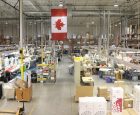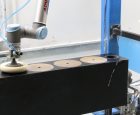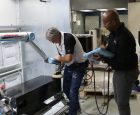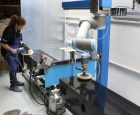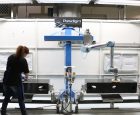
Universal Robots helps Paradigm achieve 50% production increase
October 3, 2016
By Universal Robots
Oct. 3, 2016 – Paradigm Electronics designs and manufactures speakers, offering bookshelf, centre, custom amplifier, custom outdoor, floorstanding, in-wall/in-ceiling, soundbar and subwoofer, surround/rear, and LCR speakers. Founded in 1982, its entire production process takes place in Canada.
In trying to meet demand on labour-intensive products, Paradigm implemented Universal Robots in polishing applications, resulting in “significantly increased production” throughput eliminating bottle necks while improving the work environment.
When Paradigm Electronics launched the “Midnight Cherry” finish on a line of new speakers, the market embraced the new product made entirely in-house at its Toronto location.
“Dealers loved it, our customers loved it, and we were faced with a challenge to make even more than we anticipated of these new cabinets,” says Oleg Bogdanov, director of operations, who realized it would take too long to fulfill all demands. “In order to produce that finish, you have to apply multiple layers of lacquer and between each layered application, you have to sand and buff, sand and buff. There’s a lot of manual labour involved in that. The problem is to find people who can do that, we just couldn’t find enough skilled people.”
Paradigm looked to robotics as a solution as the company had already implemented one robotic cell with a cartesian type robot.
Radical break from traditional robots
“But the cartesian robot required a lot of protective devices around it for the protection of the worker. It really didn’t allow for an employee to work in conjunction with the robot at all. The application of buffing is one that requires a lot of observation and collaboration by the operator, so having the work being done in a remote cell just didn’t seem to be a workable solution,” says John Phillips, senior manager of production services at Paradigm.
Paradigm had an industry expert with a specialty in robotics applications come in.
“Collaborative robots (were) a new technology and it lead to further investigation. This kind of robot allowed us to have a human and a robot working in the same workspace. They’re now working in a pendulum type of an operation where they can safely interact, allowing the human to check whether the robot has done an adequate amount of work before the final polishing is handed over to the human. It’s a very hand-in-hand kind of operation between the two,” says Phillips. “Usually with all of the physical guards that are required in order to make the work cell safe for the human, there’s a long implementation period. The cartesian robot that we did immediately before this one took five months. The implementation from the time of the receipt of the UR Robot was just over a month.”
Throughput increased by 50 per cent
The implementation solved Paradigm’s back log on the popular cabinets by increasing throughput by 50 per cent. Before choosing the UR robot, Paradigm conducted a thorough research of the collaborative robot market.
“Once we realized that a collaborative robot was a viable alternative for us, we did our homework and checked around the rest of the opportunities that were out there from different manufacturers. We found that for our application, the UR robot was not only the best robot for the application, but it was also the most cost efficient,” says Phillips, mentioning the UR robots’ built-in, adjustable force mode feature as another deciding factor. According to Phillips, the return of investment is expected to be realized in about 14 months.
For the loudspeaker manufacturer, it was also imperative the robot would be able to perform the polishing applying a specific force.
“The robot has taken over a really delicate job, you just make one wrong move with the sand paper and you leave a mark on the cabinet that cannot be repaired. So a robot has to be as delicate and as sensitive as a human, pressure has to be applied properly,” explains Bogdanov.
The UR robots have built-in, adjustable force mode feature that can be pre-programmed for specific applications.
“If too much force is applied, the surface heats and the results go the opposite direction to what you’d hoped. So having the ability for the robot to work to a specific force was a huge advantage. We were aware of technologies that allowed for a force feedback system but they were actually as expensive as the entire UR Robot was to us. So it was quite exciting to find that it had capabilities of force feedback within its inherent structure,” says Phillips.
Programming through dynamic teaching
The UR10 robot was first introduced to Paradigm by distributor Advanced Motion & Controls who brought the robot for an on-site demo. Technical sales representative Ben Pinto started off by showing the team how they could program the robot by simply grabbing the robot arm.
“I would do physically move the robot to the position it needed to be at and then do my fine movements using the arrow keys on the touchscreen teach pendant that comes with the robot. It was very easy for them and their programmer to quickly grasp.”
Phillips calls the UR robots very “cutting-edge” compared to old cartesian robots, not only when it comes to safety but also in the daily operation and programming requirements.
“Contrary to popular belief, the robots do not result in layoffs. They help us to free up qualified people to do other important things. Things that robots cannot do just yet,” adds Phillips.
Paradigm says it is now looking into using Universal Robots in its various paint spraying processes.
— Submitted by Universal Robots
” frameborder=”0″ allowfullscreen>
Advertisement
- Manufacturers Automation receives Moxa’s Technical Support Certification
- Guelph Economic Leadership Forum to address manufacturing innovation

